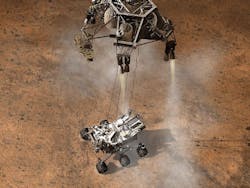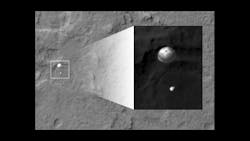Microwave Parts Help Curiosity Land Safely
To much acclaim, NASA’s Jet Propulsion Laboratory (JPL) successfully landed the “Curiosity” Rover on Mars last month. This Mars Science Laboratory (MSL) will be used to determine whether the areas around its landing can support microbial life. The rover landed in the Gale crater, which has deep layers of sediment for researchers to study. Among the components supporting its landing were a number of microwave parts.
Delta Microwave (www.deltamicrowave.com), for example, supplied L-band Global Positioning System (GPS) filter/amplifiers for the range safety system of the Atlas V launch vehicle. The firm also supplied X-band filters for the radar in the descent vehicle and ultra-high-frequency (UHF) couplers for the rover’s communications radio (Fig. 1).
1. This image shows the landing phase of the Mars Curiosity Rover—a descent that leveraged a radar system using a variety of microwave components.
Also crucial to the descent and landing—as well as the rover’s entry—was Haigh-Farr’s (www.haigh-farr.com) Wraparound Antenna system. The antenna, which consists of four segments individually mounted on the parachute cone, provides nearly full 360-deg. coverage. Haigh-Farr designed and manufactured the four-segment Wraparound Antenna at its Bedford, NH facility. At NASA JPL’s Pasadena, CA facility, the antenna was installed on top of the spacecraft that contained the rover.
Curiosity is much larger than any previous Mars Rover and five times heavier. Even as it made its descent, the rover was tasked with providing mission-critical telemetry data to NASA engineers about what it was “experiencing” (Fig. 2). MSL was the first planetary mission to use precision-guided, lifting-trajectory landing techniques.
2. The Mars Curiosity Rover has the ability to convey the largest amount of data ever obtained throughout the entry, descent, and landing process during a non-Earth entry.
While the rover can send direct messages, NASA notes that it communicates more efficiently with the help of spacecraft in orbit—including NASA’s Odyssey and Mars Reconnaissance Orbiter and the European Space Agency’s Mars Express. Across the globe, NASA’s Deep Space Network of antennae receive the transmissions. They then send them to the MSL mission operations center at NASA’s JPL.

